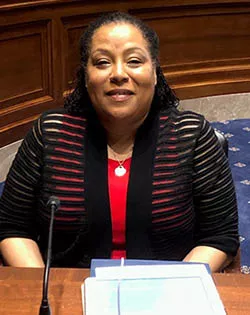This week on Capitol Hill, Sen. Chris Van Hollen and Rep. Susie Lee introduced a bill to close a gaping hole in education funding that has existed for decades.
Both Title I, which provides federal support for schools that serve large numbers of low-income children, and the Individuals with Disabilities Education Act (IDEA), which adds funding to educate special needs children, have been woefully underfunded since they became law in 1965 and 1975, respectively.
These two foundational programs were underfunded by $52 billion this year alone. Over the past 15 years, the tally is $686 billion.

The Keep Our PACT Act would increase levels for both programs over the next 10 years to reach full funding. The title means Keep Our Promise to America’s Children and Students, explained long-time education equity champion Sen. Van Hollen at a press event this morning.
Meanwhile, in nearby Silver Spring, Md., special education teacher Betsy Perry worked with groups of special needs 3rd and 5th graders at Harmony Hills Elementary School, as she does every school day.
Perry’s students, many of whom are recent arrivals in America, often have layers of needs that might include special education services, as well as supports for English language acquisition, or mental health counseling to address trauma.
“They have had interrupted schooling, they might come from poverty, many don’t speak English,” says Perry. “We know how to assist them, but it takes extra money to provide the supports that can help level the playing field for their education.”
A lot of things made possible by Title I are working well at Harmony Hills, Perry says.
“Title I funding allows us to add focus teachers to bring down class sizes,” she says. “We have wraparound services for students to see a doctor or counselor. We also have a parent-community coordinator to help families get more involved in the school and interact with teachers.”
She is heartened to see how much students benefit from the Title I-funded after-school program at Harmony Hills, Perry says. There, certified teachers provide an additional hour of math and reading instruction. Kids also have a snack and an hour of recreation before they head home.
Perry, a National Board Certified Teacher with 25 years of experience, shared her perspective with lawmakers on Tuesday at a briefing on Capitol Hill.
Too many schools that need those services and programs don’t have them, in large part because of Congress’ funding failure. That shifts the cost burden onto the states, leaving them to make tough choices.
Black, Latino, special needs, and low-income students suffer most profoundly, but the underfunding of federal education programs negatively affects all students and educators.
It simply does not have to be this way. According to a recent report by the Alliance to Reclaim Our Schools, if Title I were fully funded, all Title I schools could provide:
- Health and mental health services for every student, including dental and vision
- A full-time nurse and librarian
- A full-time additional counselor or teaching assistant in every classroom
If IDEA were fully funded:
- Every school could have an additional teacher’s assistant for every 12 students with disabilities, and there would be money left over.
Education Secretary Betsy DeVos’ budget does not call for full funding of Title I and IDEA. In fact, she proposes cutting another $7 billion from education programs, while adding $5 billion in tax credits for private school scholarships.
DeVos’ plan would drain more resources that could be invested in public schools.
“I wish I could invite Secretary DeVos to our school, to spend time with people who live and breath this work before she makes any more decisions about public education,” Perry said.
If we’re serious about education justice—ensuring that all students receive a great public education no matter what special needs they have or what ZIP code they live in—passing the PACT Act is the best first step to get us there, says elementary school educator and NEA President Lily Eskelsen García.
“As the nation continues to face a growing teacher shortage and we continue to face growing wealth and income inequality, now is the time for Congress to invest responsibly to secure the futures of our nation’s public school students,” García said.
